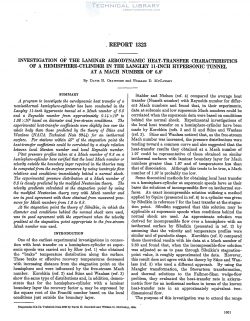naca-report-1323
- Version
- 190 Downloads
- 1.42 MB File Size
- 1 File Count
- November 2, 2016 Create Date
- November 2, 2016 Last Updated
National Advisory Committee for Aeronautics, Report - Investigation of the Laminar Aerodynamic Heat Transfer Characteristics of a Hemisphere Cylinder in the Langley 11''

A program to investigate the aerodynamic heat transfer of a
nonisothermal hemisphere-cylinder has been conducted in the
Langley 11—inch hypersonic tunnel at a Mach number of 6.8
and a Reynolds number from approximately 0.14 ><106 to
1.06 ><106 based on diameter and free-stream conditions. The
erperimental heat-transfer coeficients were slightly less over the
whole body than those predicted by the theory of Stine and
Wanlass (NAC’A Technical Note 334.4) for an isothermal
surface. For stations within 45° of the stagnation point the
heat-transfer coefiicients could be correlated by a single relation
between local Stanton number and local Reynolds number.
Pitot pressure profiles taken at a Mach number of 6.8 on a
hemisphere—cylinder have verified that the local Mach number or
velocity outside the boundary layer required in the theories may
be computed from the surface pressures by using isentropic flow
relations and conditions immediately behind a normal shock.
The erperimental pressure distribution at a Mach number of
6.8 is closely predicted by the modified Newtonian theory. The
velocity gradients calculated at the stagnation point by using
the modified Newtonian theory vary with Mach number and
are in good agreement with those obtained from measured pres—
sures jor Mach numbers from 153 to 6.8.
At the stagnation point the theory of Sibullcin, in which the
diameter and conditions behind the normal shock were used,
was in good agreement with the experiment when the velocity
gradient at the stagnation point appropriate to the free-stream
mach number was used.
One of the earliest experimental investigations in connec-
tion with heat transfer on a hemisphere-cylinder at super-
sonic speeds was carried out by Eber (ref. 1) who obtained
the “brake” temperature distribution along the surface.
These brake or effective recovery temperatures decreased
with increasing distance from the stagnation point on the
hemisphere and were influenced by the free-stream Mach
number. Korobkin (ref. 2) and Stine and Wanlass (ref. 3)
show the same type of distributions and, in addition, demon-
strate that for the hemisphere-cylinder with a laminar
boundary layer the recovery factor 71, may be expressed by
the square root of the Prandtl number based on the local
conditions just outside the boundary layer.
| File | Action |
|---|---|
| naca-report-1323 Investigation of the Laminar Aerodynamic Heat Transfer Characteristics of a Hemisphere Cylinder in the Langley 11''.pdf | Download |

Comment On This Post